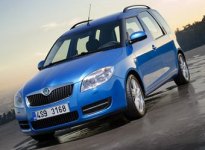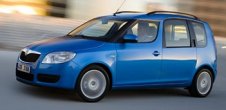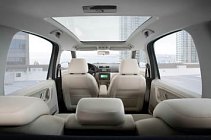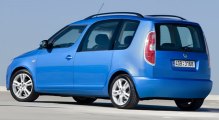|
 So
far, Skoda has been no more than a Czech factory owned by Volkswagen
AG. Its products were all derived from the existing platforms of
Volkswagen group, such as the Fabia (from Polo), Octavia (from Golf)
and Superb (from the previous Passat). Their relationships are so close
that you can hardly say Skoda has its own R&D capability. Now a
breakthrough is made by Roomster, the first car truly developed by the
Czech car maker. It is not derived from any existing platforms of
Volkswagen group, but a combination of various parts in Skoda's parts
bin. This consist of the front structure of Fabia (suspensions,
steering, engines and gearboxes) and the simple torsion-beam rear
suspension of the old Octavia, while the long-wheelbase floorpan and
spacious cabin are all new. So
far, Skoda has been no more than a Czech factory owned by Volkswagen
AG. Its products were all derived from the existing platforms of
Volkswagen group, such as the Fabia (from Polo), Octavia (from Golf)
and Superb (from the previous Passat). Their relationships are so close
that you can hardly say Skoda has its own R&D capability. Now a
breakthrough is made by Roomster, the first car truly developed by the
Czech car maker. It is not derived from any existing platforms of
Volkswagen group, but a combination of various parts in Skoda's parts
bin. This consist of the front structure of Fabia (suspensions,
steering, engines and gearboxes) and the simple torsion-beam rear
suspension of the old Octavia, while the long-wheelbase floorpan and
spacious cabin are all new.
Of course, the funky exterior design is also the work by Skoda itself.
It breaks away from the conservative theme of Volkswagen and the
previous Skoda. The design features blackened A-pillars and irregular
shape rear side windows which you can describe it odd or unusual. The
body profile is actually oriented to practicality, as it is very tall
and optimized for cargo volume (see its name Roomster). At first
acquaintance it appears to be a rival to Citroen Berlingo and Renault
Kangoo – those workmen's cars. But open the doors and you'll notice its
decent quality and flexible seating plans rival Multi Activity Vehicles
like Renault Scenic. It is a crossover between the two segments.
 Benefited
by the tall roof and big windows (especially the rear side windows),
the cabin of Roomster feels light and airy while provides ample of
headroom. The front seats and steering wheel are multi-adjustable, so
finding a comfortable seating position is easy. Rear passengers sit
higher than the front to enable a good view forward. However, they do
not sacrifice any headroom, because the roofline rises towards the
tail. Rear legroom is benefited by the long wheelbase of 2617mm (that's
longer than Octavia and Golf), so Roomster is a real room star. Benefited
by the tall roof and big windows (especially the rear side windows),
the cabin of Roomster feels light and airy while provides ample of
headroom. The front seats and steering wheel are multi-adjustable, so
finding a comfortable seating position is easy. Rear passengers sit
higher than the front to enable a good view forward. However, they do
not sacrifice any headroom, because the roofline rises towards the
tail. Rear legroom is benefited by the long wheelbase of 2617mm (that's
longer than Octavia and Golf), so Roomster is a real room star.
 In terms
of flexibility, the rear seats are just brilliant. You can slide them,
fold them, flip them forward (to reveal a big loading area) or even
detach them individually. In the latter form the luggage area is big
enough to store 2 or 3 mountain bikes. That's not all though. If you
want to sit four people more comfortably, you can take the center rear
seat out and slide the two outer seats closer together (like Opel
Meriva). In this way both passengers will enjoy enormous shoulder room
in addition to the generous head and legroom. Judging by packaging,
Roomster is definitely more innovative than any Volkswagen group
products. In terms
of flexibility, the rear seats are just brilliant. You can slide them,
fold them, flip them forward (to reveal a big loading area) or even
detach them individually. In the latter form the luggage area is big
enough to store 2 or 3 mountain bikes. That's not all though. If you
want to sit four people more comfortably, you can take the center rear
seat out and slide the two outer seats closer together (like Opel
Meriva). In this way both passengers will enjoy enormous shoulder room
in addition to the generous head and legroom. Judging by packaging,
Roomster is definitely more innovative than any Volkswagen group
products.
For cost and for packaging benefits, the Roomster uses the same
torsion-beam rear suspension from the Golf IV and last generation
Octavia. But it compensates with a well-judged setting and a wider rear
track. The result is a smooth and quiet ride and tidy body control.
Various British journalists said they enjoyed the car's ride and
handling. This is hardly a surprise, as the Roomster's suspension
setting was designed to ride well on the rough Czech roads, which is
similar to the situation in the UK.
 The
weakest area is performance. Roomster is available with 3 petrol
engines (70hp 1.2-litre three-pot, 85hp 1.4-litre, 105hp 1.6-litre) and
none of them get FSI direct injection like its Volkswagen cousins
because it wants to keep price low. Like-wise, the diesel engines (70hp
1.4TDI three-pot, 80hp 1.4TDI three-pot and 105hp 1.9TDI) are also the
most outdated in Volkswagen's parts bin. None of these engines can
propel it from 0 to 60 mph in less than 10 seconds. The
weakest area is performance. Roomster is available with 3 petrol
engines (70hp 1.2-litre three-pot, 85hp 1.4-litre, 105hp 1.6-litre) and
none of them get FSI direct injection like its Volkswagen cousins
because it wants to keep price low. Like-wise, the diesel engines (70hp
1.4TDI three-pot, 80hp 1.4TDI three-pot and 105hp 1.9TDI) are also the
most outdated in Volkswagen's parts bin. None of these engines can
propel it from 0 to 60 mph in less than 10 seconds.
If Skoda want, it can easily put a 150hp 1.8 turbo engine into the
Roomster (like Polo GTI). But that's not the purpose of this car. We
had better look at its refined engines (at least for the petrol), slick
gearshift and the free of wind noise. These qualities are equally
important to the driving pleasure. The Roomster is slow, but it is fun
and useful.
|